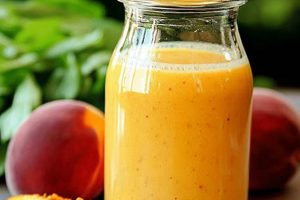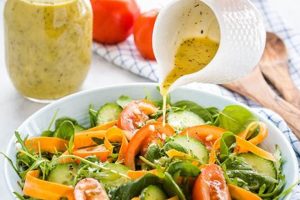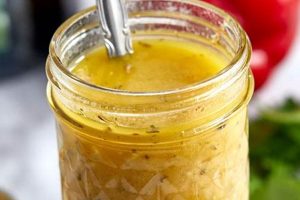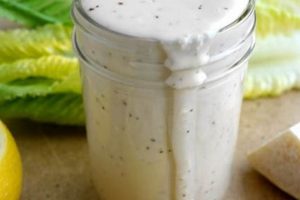A blend of olive oil with acidic components like vinegar or citrus juice, often enhanced by herbs, spices, and other flavoring agents, forms the foundation of many culinary traditions. A basic example includes extra virgin olive oil, lemon juice, salt, and pepper. Variations can incorporate ingredients such as Dijon mustard, garlic, honey, or different types of vinegar like balsamic or red wine vinegar.
Emulsified mixtures of oil and acid provide a healthy and flavorful way to enhance salads and other dishes. Olive oil, in particular, offers monounsaturated fats and antioxidants, contributing to potential health benefits. Historically, such mixtures have been utilized across cultures, evolving from simple combinations to more complex recipes reflecting regional flavors and ingredient availability. The versatility of these mixtures allows for customization based on personal preferences and dietary needs.
This exploration will delve further into the core components, the creation process, and various flavor profiles achievable through different ingredient combinations. Additionally, guidance on proper storage and practical tips for achieving optimal emulsion stability will be provided.
Tips for Crafting Exceptional Olive Oil-Based Dressings
Achieving a balanced and flavorful dressing requires attention to detail and an understanding of key principles.
Tip 1: Use High-Quality Olive Oil: The flavor of the olive oil significantly impacts the final result. Extra virgin olive oil, known for its robust flavor and health benefits, is generally preferred. Opt for cold-pressed varieties for the purest taste.
Tip 2: Balance Acidity: Acidity provides brightness and complements the richness of the oil. A common ratio is three parts oil to one part acid. Experiment with different vinegars or citrus juices to find preferred flavor profiles. Lemon juice offers a refreshing zest, while balsamic vinegar contributes a deeper, sweeter note.
Tip 3: Emulsify Effectively: Proper emulsification creates a smooth, cohesive texture. Whisk the ingredients vigorously or use a blender to combine the oil and acid thoroughly. Adding a small amount of Dijon mustard can act as an emulsifier, helping to stabilize the mixture.
Tip 4: Season Carefully: Salt and freshly ground black pepper are essential seasonings. Start with a small amount and adjust to taste. Other seasonings, like garlic powder, onion powder, or dried herbs, can be added judiciously.
Tip 5: Explore Flavor Combinations: Fresh herbs, such as parsley, thyme, or oregano, can elevate the dressing’s complexity. Minced garlic or shallots add pungent notes. Incorporating ingredients like honey, maple syrup, or a pinch of sugar can balance acidity and introduce subtle sweetness.
Tip 6: Taste and Adjust: Before serving, taste the dressing and adjust seasonings as needed. The balance of flavors might change after resting, so re-tasting after a short period is recommended.
Tip 7: Store Properly: Store leftover dressing in an airtight container in the refrigerator for up to one week. Allow the dressing to come to room temperature before serving to enhance the flavors.
Adhering to these guidelines ensures a consistently delicious and well-balanced dressing, elevating any salad or dish.
By understanding these fundamental principles, one can confidently create custom dressings tailored to individual preferences.
1. High-quality olive oil
The foundation of a superior olive oil salad dressing rests upon the quality of its primary ingredient: olive oil. Selecting high-quality olive oil significantly impacts the final flavor, aroma, and potential health benefits of the dressing. Understanding the characteristics of high-quality olive oil is crucial for crafting exceptional dressings.
- Extra Virgin Olive Oil:
Extra virgin olive oil, the highest grade of olive oil, results from the first cold-pressing of olives. This process preserves the natural flavors, aromas, and beneficial compounds. Its rich, fruity flavor and low acidity make it ideal for salad dressings. Cheaper, refined olive oils lack the distinct character and health benefits of extra virgin olive oil, potentially compromising the dressing’s quality. Selecting extra virgin ensures a superior sensory experience and contributes to the dressing’s overall nutritional value.
- Acidity Level:
Acidity, a natural characteristic of olive oil, plays a vital role in flavor and shelf life. High-quality extra virgin olive oil typically exhibits an acidity level below 0.8%. Lower acidity correlates with a smoother, less bitter taste, enhancing the overall balance within the dressing. A higher acidity level can introduce unwanted sharpness, detracting from the other ingredients.
- Flavor Profile:
Olive oil exhibits a range of flavor profiles, from delicate and fruity to robust and peppery. These variations stem from factors like olive variety, terroir, and harvest time. Selecting an olive oil with a flavor profile that complements the other dressing ingredients is essential. For example, a mild, fruity olive oil might pair well with citrus-based dressings, while a more robust oil might be suitable for dressings with stronger flavors like garlic or herbs. Careful consideration of flavor profiles allows for a harmonious blend within the final dressing.
- Storage and Freshness:
Olive oil is susceptible to degradation from light, heat, and air exposure. Storing olive oil in a cool, dark place in an airtight container preserves its quality and extends its shelf life. Using fresh, properly stored olive oil ensures optimal flavor and minimizes the risk of off-flavors developing within the dressing. Freshness is paramount for maintaining the integrity of the final product.
By prioritizing these aspects of olive oil selection, one ensures that the foundation of the salad dressing is of the highest caliber, ultimately contributing to a more flavorful and healthful culinary experience. Choosing high-quality olive oil not only elevates the taste of the dressing but also reflects a commitment to using premium ingredients.
2. Balanced Acidity
Balanced acidity is paramount in olive oil salad dressings, acting as a counterpoint to the richness of the oil and contributing to a harmonious flavor profile. Acidity provides brightness, enhances other flavors, and plays a crucial role in the overall sensory experience. Understanding the nuances of acidity allows for precise control over the dressing’s character.
- The Role of Acid:
Acidic ingredients, such as vinegar or citrus juice, introduce tartness that cuts through the fattiness of olive oil. This balance prevents the dressing from being overly rich or heavy. The acid also interacts with other ingredients, enhancing their flavors and creating a more complex taste. Without sufficient acidity, a dressing can taste flat and unappealing.
- Types of Acid:
Various acidic ingredients offer unique flavor profiles and levels of intensity. Common choices include lemon juice, red wine vinegar, balsamic vinegar, and apple cider vinegar. Lemon juice provides a bright, citrusy note, while red wine vinegar adds a subtle tang. Balsamic vinegar contributes a deeper, sweeter acidity, and apple cider vinegar offers a slightly fruity tartness. The choice of acid significantly influences the final character of the dressing.
- Achieving Balance:
A general guideline for balancing acidity in olive oil dressings is a ratio of three parts oil to one part acid. However, this ratio can be adjusted based on personal preference and the specific ingredients used. Tasting and adjusting throughout the process is crucial for achieving the desired level of acidity. Factors such as the intensity of the olive oil and the presence of other flavorful ingredients also influence the optimal balance.
- Impact on Emulsification:
Acidity plays a role in the emulsification process, affecting the stability of the mixture. The pH level of the acidic ingredient influences how well the oil and water-based components combine and remain emulsified. While not the sole determinant of emulsion stability, acidity contributes to the dressing’s overall texture and its ability to resist separation.
Mastering the balance of acidity in olive oil salad dressings is essential for creating flavorful and well-rounded culinary experiences. The interplay between oil and acid forms the foundation of a successful dressing, impacting not only taste but also texture and overall appeal. Careful consideration of acid type, ratio, and its interaction with other ingredients allows for the creation of dressings tailored to individual preferences and specific culinary applications.
3. Effective Emulsification
Effective emulsification is crucial for creating a stable and visually appealing olive oil salad dressing. Emulsification refers to the process of combining two immiscible liquids, such as oil and water (vinegar or citrus juice), into a homogenous mixture. A properly emulsified dressing exhibits a smooth, creamy texture and resists separation, ensuring a consistent flavor experience in every bite.
- Temporary vs. Permanent Emulsions:
Olive oil salad dressings typically form temporary emulsions, meaning the oil and water phases eventually separate. The goal is to create an emulsion stable enough to last throughout the meal. Permanent emulsions, achieved through the addition of powerful emulsifiers like egg yolks (as in mayonnaise), are generally not desired in vinaigrettes, as they alter the texture and flavor profile.
- The Role of Emulsifiers:
Emulsifiers contain both hydrophilic (water-loving) and lipophilic (oil-loving) components, allowing them to bridge the gap between the oil and water phases. Common emulsifiers in olive oil salad dressings include Dijon mustard, honey, and even finely minced garlic. These ingredients help to create smaller oil droplets dispersed throughout the water phase, increasing the emulsion’s stability.
- Techniques for Emulsification:
Vigorous whisking or blending facilitates the breakdown of oil droplets and their even distribution within the water phase. Slow, steady addition of the oil to the water phase while whisking continuously promotes better emulsification. Alternatively, all ingredients can be combined in a sealed container and shaken vigorously. The method chosen influences the final texture and stability of the emulsion.
- Factors Affecting Stability:
Several factors influence emulsion stability. Temperature plays a significant role; extreme temperatures can destabilize the emulsion. The ratio of oil to water also affects stability, with higher oil concentrations generally requiring more vigorous emulsification. The presence of solids, such as herbs or spices, can either stabilize or destabilize the emulsion depending on their properties and particle size.
A stable emulsion ensures that the olive oil and other ingredients remain evenly dispersed throughout the dressing, delivering a consistent flavor and pleasant texture. Understanding the principles of emulsification allows for the creation of dressings that are not only flavorful but also visually appealing and texturally satisfying, enhancing the overall culinary experience.
4. Appropriate Seasoning
Appropriate seasoning is fundamental to a successful olive oil salad dressing recipe. It elevates the inherent flavors of the ingredients, creating complexity and balance. Seasoning not only enhances taste but also contributes to the overall sensory experience of the dressing.
- Salt:
Salt is the cornerstone of seasoning, enhancing the perception of sweetness and suppressing bitterness. In olive oil salad dressings, salt not only seasons the ingredients but also plays a crucial role in the emulsification process, helping to stabilize the mixture. The type of salt used can influence the final flavor; kosher salt or sea salt are generally preferred for their clean taste and ease of use. Over-salting can easily overpower the other flavors, while under-salting can result in a bland dressing. Careful attention to salt levels is essential.
- Black Pepper:
Freshly ground black pepper adds a subtle heat and complexity to olive oil dressings. Its pungent aroma complements the fruity notes of olive oil and the acidity of vinegar or citrus juice. Pre-ground pepper can lose its potency over time, resulting in a less flavorful dressing. Freshly grinding peppercorns just before adding them to the dressing ensures optimal flavor and aroma.
- Herbs and Spices:
Fresh or dried herbs and spices introduce layers of flavor and aroma to olive oil dressings. Fresh herbs like parsley, oregano, thyme, and chives impart bright, herbaceous notes. Dried herbs, such as oregano, basil, and rosemary, offer more concentrated flavors. Spices like paprika, cumin, and chili flakes can add warmth and depth. The choice of herbs and spices should complement the other ingredients in the dressing and the dish it accompanies.
- Acid Adjustment:
While not strictly a seasoning, the acidity level significantly impacts the overall flavor profile of the dressing. A pinch of sugar or a small amount of honey can help balance excessive acidity, rounding out the flavor and creating a more harmonious taste. Careful adjustment of acidity ensures that the dressing complements the other ingredients without being overly tart.
Careful consideration of these seasoning elements ensures a well-balanced and flavorful olive oil salad dressing. The interplay between salt, pepper, herbs, spices, and acidity creates a complex tapestry of flavors that elevate the overall dining experience. Appropriate seasoning transforms a simple mixture of oil and acid into a culinary delight, enhancing the flavors of the salad and showcasing the versatility of olive oil-based dressings.
5. Flavorful additions
Flavorful additions represent a crucial element within olive oil salad dressing recipes, transforming a simple base of oil and acid into a complex and nuanced culinary creation. These additions contribute depth, aroma, and textural variation, elevating the sensory experience of the dressing and its interaction with the accompanying dish. Understanding the role and impact of various flavorful additions allows for customization and creativity, tailoring the dressing to specific flavor profiles and culinary applications.
A wide array of ingredients can serve as flavorful additions, each contributing unique characteristics. Fresh herbs, such as basil, mint, dill, or tarragon, introduce vibrant herbaceous notes. Incorporating alliums, like minced garlic, shallots, or chives, adds pungent depth. Spices, ranging from mild paprika to fiery chili flakes, introduce warmth and complexity. Other additions, like grated Parmesan cheese, toasted nuts, or dried fruits, offer textural contrasts and distinct flavor profiles. For example, a Mediterranean-inspired dressing might benefit from the addition of chopped Kalamata olives and oregano, while a dressing intended for a vibrant summer salad might be enhanced by fresh mint and crumbled feta cheese. The thoughtful selection and combination of these additions determine the final character of the dressing, creating endless possibilities for flavor exploration.
The incorporation of flavorful additions requires careful consideration of balance and synergy. The intensity of each addition should complement, not overpower, the other ingredients and the main components of the salad. Excessive use of strong flavors can mask the delicate nuances of the olive oil and other components. Additionally, the compatibility of flavors is crucial. For example, combining pungent garlic with delicate herbs requires careful balancing to avoid a clash of flavors. Achieving harmony among the various components ensures a well-rounded and palatable dressing that enhances, rather than detracts from, the overall culinary experience. Mastering the art of flavorful additions enables the creation of olive oil salad dressings that are not only delicious but also tailored to individual preferences and specific culinary contexts.
Frequently Asked Questions
This section addresses common inquiries regarding olive oil-based salad dressings, providing concise and informative responses.
Question 1: What is the ideal ratio of olive oil to acid in a salad dressing?
While a 3:1 ratio of oil to acid serves as a general guideline, the optimal balance depends on the specific ingredients and desired flavor profile. Stronger acids, like lemon juice, might require a higher oil ratio, while milder vinegars may necessitate less oil. Tasting and adjusting throughout the preparation process is crucial.
Question 2: How can emulsion separation be prevented?
Emulsion stability can be enhanced through the use of emulsifying agents like Dijon mustard or honey. Vigorous whisking or blending also contributes to a more stable emulsion. Storing the dressing in a sealed container and shaking well before serving helps to recombine any separated components.
Question 3: What type of olive oil is best suited for salad dressings?
Extra virgin olive oil, with its robust flavor and aroma, is generally preferred for salad dressings. Its low acidity contributes to a balanced taste. However, other olive oil varieties can be used depending on the desired flavor profile.
Question 4: How long can olive oil salad dressing be stored?
When stored properly in an airtight container in the refrigerator, olive oil salad dressing typically lasts for up to one week. However, the presence of fresh ingredients, like herbs or garlic, may shorten the shelf life. Always check for signs of spoilage before consuming.
Question 5: Can olive oil salad dressings be used for marinades?
The acidic component in olive oil salad dressings can tenderize certain foods, making them suitable for marinades. However, prolonged marinating times, especially with highly acidic dressings, can result in a mushy texture. Adjust marinating times based on the food and the dressing’s acidity.
Question 6: How can one adjust the flavor of an overly acidic dressing?
A small amount of honey, maple syrup, or a pinch of sugar can help balance excessive acidity in a salad dressing. Alternatively, adding more olive oil can also help to mellow the tartness. Taste and adjust incrementally until the desired balance is achieved.
Understanding these fundamental aspects allows for the creation of flavorful and well-balanced olive oil salad dressings tailored to individual preferences.
This concludes the frequently asked questions section. The subsequent segment will delve into specific recipe variations, showcasing the versatility of olive oil-based dressings.
Olive Oil Salad Dressing Recipes
Exploration of olive oil-based salad dressings reveals their significance as versatile culinary components. Emphasis on quality ingredients, balanced acidity, effective emulsification, and appropriate seasoning contributes to optimal flavor and texture. Understanding these elements allows for customization and adaptation to diverse palates and culinary applications. From classic vinaigrettes to innovative flavor combinations, the possibilities within this culinary realm are extensive.
The ability to craft a well-balanced and flavorful olive oil salad dressing empowers culinary creativity and enhances the dining experience. Continued exploration of ingredient combinations and techniques promises further development and appreciation of this essential culinary element.






